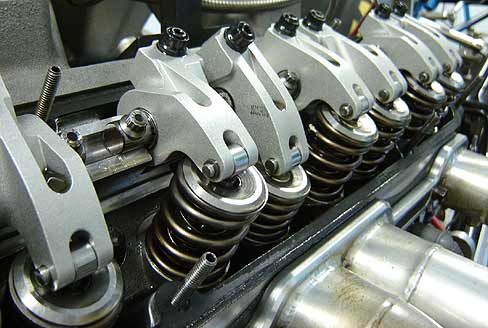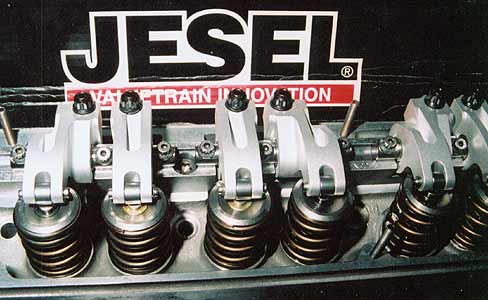|

Looking for rocker arm
durability and quality

The final picture (unless you help me check valve lash each
week!) shows the 1.6 Jesel's installed and ready to go racing.
The attention to detail and top flite hardware is evident.
The hollow adjusters are drilled with a small bleed hole to
supply oil to the top of the pushrod and adjuster ball.
7/11/05
 f
you are a racer or have a hobby you are passionate about,
then you are aware of items you can buy that promise better
durability, better performance and in most cases “more
bang for your buck.” Not all of you are familiar with
big block Mopars, but you are probably aware of certain “weak
links” in your engine combination. The big block Mopars
have an inherent problem in the rocker arm, rocker arm shaft
and pushrod oiling area. Big block Chevrolets suffered from
weak castings in OEM blocks when more horsepower was added.
The aftermarket industry usually responds with parts that
help solve the problems if there is enough demand to justify
the costs of designing a cure for these “weak links.” f
you are a racer or have a hobby you are passionate about,
then you are aware of items you can buy that promise better
durability, better performance and in most cases “more
bang for your buck.” Not all of you are familiar with
big block Mopars, but you are probably aware of certain “weak
links” in your engine combination. The big block Mopars
have an inherent problem in the rocker arm, rocker arm shaft
and pushrod oiling area. Big block Chevrolets suffered from
weak castings in OEM blocks when more horsepower was added.
The aftermarket industry usually responds with parts that
help solve the problems if there is enough demand to justify
the costs of designing a cure for these “weak links.”
Since I have been racing big block Mopars for over 25 years,
I have found some of these “weak links” that are
inherent to the 383-440” Mopars. About the only problem
I have ever had with my Mopars is in the vale train area.
I have tried every brand of aluminum and ductile iron rocker
arm there is. They work OK but they all use the stock shaft
size and stock pedestals that are cast into all big block
Mopar cylinder heads. This is the main source of the problem,
as the shaft diameter limits the thickness of the rocker arm
near the inside edge of the valve spring retainer.

The finished Jesel Rocker Arm System,
Comp Cam springs and retainers all set to go racing. The adjuster
stud is drilled with a small hole (about .060") to let
oil from the spray bars run down on the tip of the pushrod.

|
